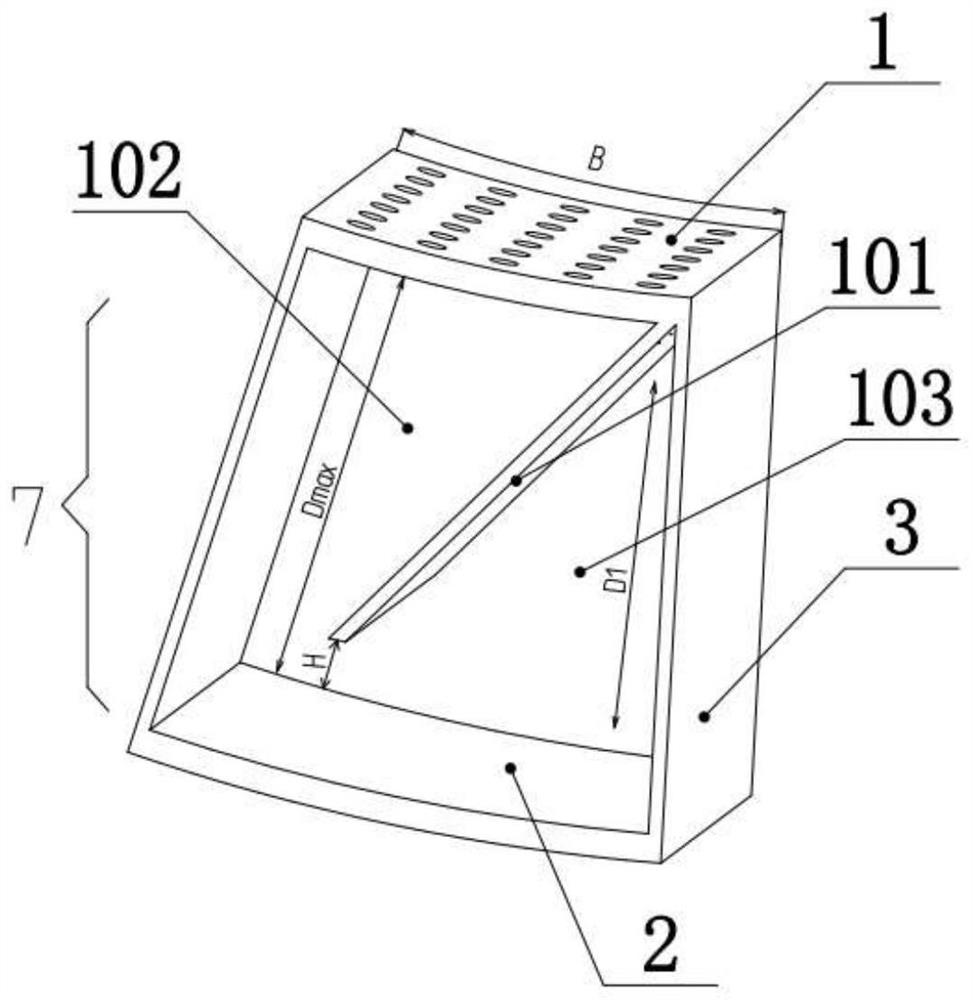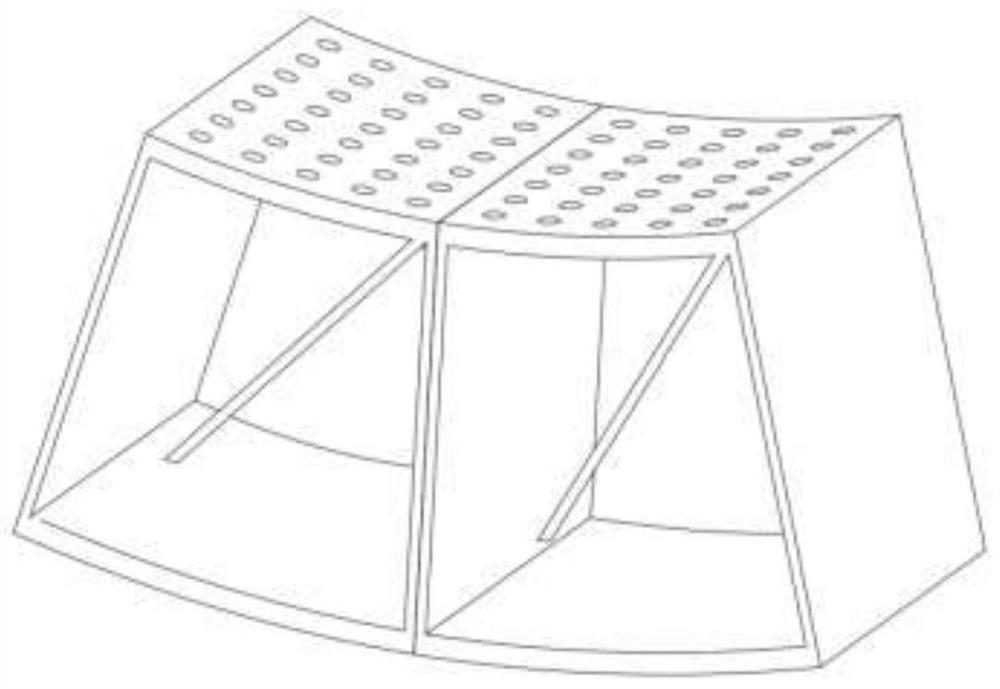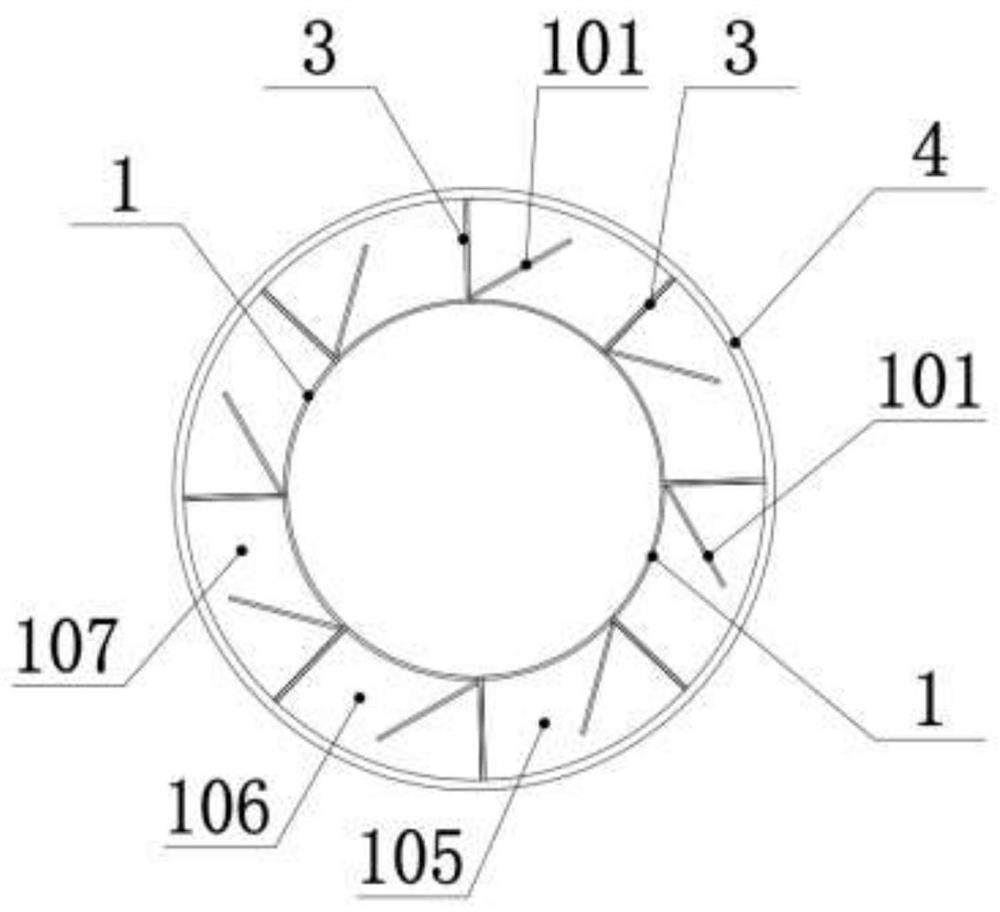Method for improving noise reduction effect of low-frequency noise reduction acoustic backing of pipeline and acoustic backing
A technology for noise reduction and pipelines, applied in the direction of pipe components, pipes/pipe joints/pipes, mechanical equipment, etc., can solve the problems of no airflow environment, resonance sound absorption frequency dependent, sound absorption material escape, etc., to achieve enhanced noise reduction. Noise effect, widening noise frequency band, increasing runner length effect
- Summary
- Abstract
- Description
- Claims
- Application Information
AI Technical Summary
Problems solved by technology
Method used
Image
Examples
Embodiment 1
[0048] Such as figure 1 As shown, the acoustic lining to improve the noise reduction effect of the pipeline low-frequency noise reduction lining includes a micro-perforated plate 1 and a sound-absorbing cavity tube 7; the sound-absorbing cavity tube 7 includes a back plate 2 set opposite to the micro-perforated plate 1, and the micro-perforated plate 1 and the back plate 2 are connected by side plates 3; there are four side plates 3 in total, which are two side plates 3 relatively arranged in the length direction of the micro-perforated plate 1 and the back plate 2, and two side plates 3 relatively arranged in the micro-perforated plate 1 and the back plate 2. The two side plates 3 in the width direction of the plate 1 and the back plate 2, in order to facilitate the display of the structure in the cavity of the sound-absorbing unit, the two side plates 3 in the width direction of the micro-perforated plate 1 and the back plate 2 are not shown in the drawings Out; the back pla...
Embodiment 2
[0053] The difference between this embodiment and Embodiment 1 is that: Figure 4 As shown, a second partition plate 201 and a ninth partition plate 202 are also arranged in the second small lumen tube 103, and one end of the second partition plate 201 is fixed on the back plate 2, and the second partition plate 201 The other end is a free end; one end of the ninth dividing plate 202 is fixedly connected to the right side plate 3, and the other end of the ninth dividing plate 202 is fixedly connected to the first dividing plate 101; the second dividing plate 201 and The ninth partition plate 202 separates the second small lumen 103 into a third small lumen 203 and a fourth small lumen 204 . Through the above arrangement, the flow channel length of the noise in the second small lumen tube 103 is increased by setting the second partition plate 201 in the second small lumen tube 103, as Figure 5 As shown, the increased flow path length is the dotted line S; and by setting the n...
Embodiment 3
[0056] as attached Figure 7 As shown, the difference between the present embodiment and the second embodiment is that the sound-absorbing unit is radially superimposed toward the inner wall of the pipe, and the superposition of the two acoustic linings is the middle plate 6, which also adopts the micro-perforated plate 1 material production. When the noise enters the fourth sound-absorbing unit 601 from the holes of the micro-perforated plate 1, part of the noise stays in the fourth sound-absorbing unit 601 for noise reduction according to the method of Embodiment 2, and the other part of the noise flows downward into the fifth sound-absorbing unit 601. The sound-absorbing unit 602 performs noise reduction according to the method of the second embodiment, so that the sound-absorbing unit can expand the sound-absorbing frequency range within a limited installation height range, making the entire sound lining applicable to a wider range of scenarios.
[0057] Such as Figure ...
PUM
| Property | Measurement | Unit |
|---|---|---|
| Installation height | aaaaa | aaaaa |
| Aperture | aaaaa | aaaaa |
| Thickness | aaaaa | aaaaa |
Abstract
Description
Claims
Application Information
 Login to View More
Login to View More - R&D
- Intellectual Property
- Life Sciences
- Materials
- Tech Scout
- Unparalleled Data Quality
- Higher Quality Content
- 60% Fewer Hallucinations
Browse by: Latest US Patents, China's latest patents, Technical Efficacy Thesaurus, Application Domain, Technology Topic, Popular Technical Reports.
© 2025 PatSnap. All rights reserved.Legal|Privacy policy|Modern Slavery Act Transparency Statement|Sitemap|About US| Contact US: help@patsnap.com



